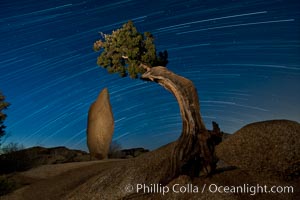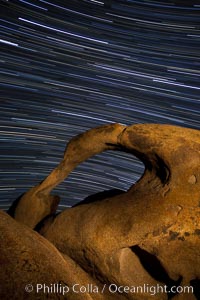
Mobius Arch in the Alabama Hills, seen here at night with swirling star trails formed in the sky above due to a long time exposure.
Location: Alabama Hills Recreational Area, California
Image ID: 27673
Location: Alabama Hills Recreational Area, California
Image ID: 27673

Live Oak and Milky Way, rocks and stars, Joshua Tree National Park at night.
Location: Joshua Tree National Park, California
Image ID: 28424
Location: Joshua Tree National Park, California
Image ID: 28424
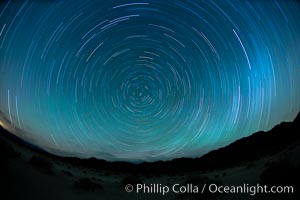
Star trails, rotating around the North Star (Polaris), seen from Death Valley.
Location: Milky Way Galaxy, The Universe
Image ID: 25270
Location: Milky Way Galaxy, The Universe
Image ID: 25270

Stars and the Milky Way rise above ancient bristlecone pine trees, in the White Mountains at an elevation of 10,000' above sea level. These are some of the oldest trees in the world, reaching 4000 years in age.
Species: Bristlecone pine, Pinus longaeva
Location: Ancient Bristlecone Pine Forest, White Mountains, Inyo National Forest, California
Image ID: 27776
Species: Bristlecone pine, Pinus longaeva
Location: Ancient Bristlecone Pine Forest, White Mountains, Inyo National Forest, California
Image ID: 27776

Stars and the Milky Way rise above ancient bristlecone pine trees, in the White Mountains at an elevation of 10,000' above sea level. These are some of the oldest trees in the world, reaching 4000 years in age.
Species: Bristlecone pine, Pinus longaeva
Location: Ancient Bristlecone Pine Forest, White Mountains, Inyo National Forest, California
Image ID: 27780
Species: Bristlecone pine, Pinus longaeva
Location: Ancient Bristlecone Pine Forest, White Mountains, Inyo National Forest, California
Image ID: 27780
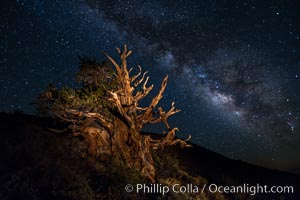
Stars and the Milky Way rise above ancient bristlecone pine trees, in the White Mountains at an elevation of 10,000' above sea level. These are some of the oldest trees in the world, reaching 4000 years in age.
Species: Bristlecone pine, Pinus longaeva
Location: Ancient Bristlecone Pine Forest, White Mountains, Inyo National Forest, California
Image ID: 27782
Species: Bristlecone pine, Pinus longaeva
Location: Ancient Bristlecone Pine Forest, White Mountains, Inyo National Forest, California
Image ID: 27782
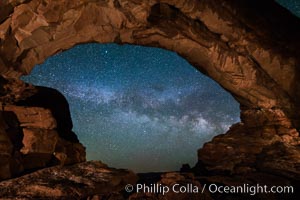
Milky Way through North Window, Arches National Park.
Location: North Window, Arches National Park, Utah
Image ID: 29277
Location: North Window, Arches National Park, Utah
Image ID: 29277

Stars, moonlit clouds and the Milky Way over ancient bristlecone pine trees, in the White Mountains at an elevation of 10,000' above sea level. These are some of the oldest trees in the world, some exceeding 4000 years in age.
Species: Bristlecone pine, Pinus longaeva
Location: Ancient Bristlecone Pine Forest, White Mountains, Inyo National Forest, California
Image ID: 29405
Species: Bristlecone pine, Pinus longaeva
Location: Ancient Bristlecone Pine Forest, White Mountains, Inyo National Forest, California
Image ID: 29405
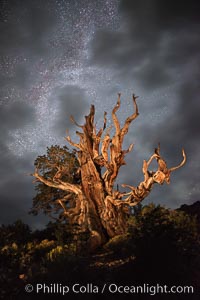
Stars and the Milky Way rise above ancient bristlecone pine trees, in the White Mountains at an elevation of 10,000' above sea level. These are some of the oldest trees in the world, some exceeding 4000 years in age.
Species: Bristlecone pine, Pinus longaeva
Location: Ancient Bristlecone Pine Forest, White Mountains, Inyo National Forest, California
Image ID: 29408
Species: Bristlecone pine, Pinus longaeva
Location: Ancient Bristlecone Pine Forest, White Mountains, Inyo National Forest, California
Image ID: 29408

Palomar Observatory at Night under the Milky Way, Panoramic photograph.
Location: Palomar Observatory, Palomar Mountain, California
Image ID: 29340
Location: Palomar Observatory, Palomar Mountain, California
Image ID: 29340

Palomar Observatory at Night under the Milky Way, Panoramic photograph.
Location: Palomar Observatory, Palomar Mountain, California
Image ID: 29341
Location: Palomar Observatory, Palomar Mountain, California
Image ID: 29341

Palomar Observatory at Night under the Milky Way, Panoramic photograph.
Location: Palomar Observatory, Palomar Mountain, California
Image ID: 29349
Location: Palomar Observatory, Palomar Mountain, California
Image ID: 29349

The Milky Way at Night over Sky Rock. Sky Rock petroglyphs near Bishop, California. Hidden atop an enormous boulder in the Volcanic Tablelands lies Sky Rock, a set of petroglyphs that face the sky. These superb examples of native American petroglyph artwork are thought to be Paiute in origin, but little is known about them.
Location: Bishop, California
Image ID: 28798
Location: Bishop, California
Image ID: 28798

Arch Rock and star trails, impending dawn.
Location: Joshua Tree National Park, California
Image ID: 28415
Location: Joshua Tree National Park, California
Image ID: 28415

The Milky Way rises above a huge wall of stone, stars fill the night sky and soar over the distant lights of campers.
Location: Joshua Tree National Park, California
Image ID: 27898
Location: Joshua Tree National Park, California
Image ID: 27898

Lunar eclipse sequence, showing total eclipse (left) through full moon (right). While the moon lies in the full shadow of the earth (umbra) it receives only faint, red-tinged light refracted through the Earth's atmosphere. As the moon passes into the penumbra it receives increasing amounts of direct sunlight, eventually leaving the shadow of the Earth altogether. August 28, 2007.
Location: Earth Orbit, Solar System, Milky Way Galaxy, The Universe
Image ID: 19391
Panorama dimensions: 1826 x 14162
Location: Earth Orbit, Solar System, Milky Way Galaxy, The Universe
Image ID: 19391
Panorama dimensions: 1826 x 14162

Mobius Arch in the Alabama Hills, seen here at night with swirling star trails formed in the sky above due to a long time exposure. Polaris, the North Star, is visible at upper right.
Location: Alabama Hills Recreational Area, California
Image ID: 27677
Location: Alabama Hills Recreational Area, California
Image ID: 27677
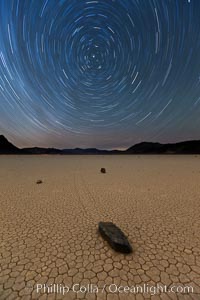
Racetrack sailing stone and star trails. A sliding rock of the Racetrack Playa. The sliding rocks, or sailing stones, move across the mud flats of the Racetrack Playa, leaving trails behind in the mud. The explanation for their movement is not known with certainty, but many believe wind pushes the rocks over wet and perhaps icy mud in winter.
Location: Racetrack Playa, Death Valley National Park, California
Image ID: 27668
Location: Racetrack Playa, Death Valley National Park, California
Image ID: 27668

Milky Way galaxy rises above the Fire Wave, Valley of Fire State Park.
Location: Valley of Fire State Park, Nevada
Image ID: 28555
Location: Valley of Fire State Park, Nevada
Image ID: 28555
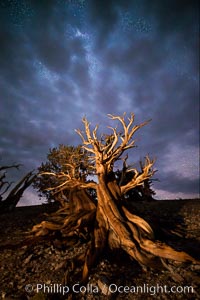
Ancient Bristlecone Pine Tree at night, stars and the Milky Way galaxy visible in the evening sky, near Patriarch Grove.
Species: Ancient bristlecone pine, Pinus longaeva
Location: Ancient Bristlecone Pine Forest, White Mountains, Inyo National Forest, California
Image ID: 28785
Species: Ancient bristlecone pine, Pinus longaeva
Location: Ancient Bristlecone Pine Forest, White Mountains, Inyo National Forest, California
Image ID: 28785

The OVRO 40 meter Telescope, part of the Owens Valley Radio Observatory located near Big Pine, California, USA. The telescope is used to conduct interferometric observations along with the other telescopes in the observatory, as a Very Long Baseline Interferometry (VLBI) station and as a single dish instrument. Its main focus today is on the monitoring of blazars.
Location: Big Pine, California
Image ID: 28790
Location: Big Pine, California
Image ID: 28790

Stars and the Milky Way rise above ancient bristlecone pine trees, in the White Mountains at an elevation of 10,000' above sea level. These are some of the oldest trees in the world, reaching 4000 years in age.
Species: Bristlecone pine, Pinus longaeva
Location: Ancient Bristlecone Pine Forest, White Mountains, Inyo National Forest, California
Image ID: 27777
Species: Bristlecone pine, Pinus longaeva
Location: Ancient Bristlecone Pine Forest, White Mountains, Inyo National Forest, California
Image ID: 27777

The Milky Way galaxy arcs over Arch Rock on a clear evening in Joshua Tree National Park.
Location: Joshua Tree National Park, California
Image ID: 26793
Location: Joshua Tree National Park, California
Image ID: 26793

Stars and the Milky Way rise above ancient bristlecone pine trees, in the White Mountains at an elevation of 10,000' above sea level. These are some of the oldest trees in the world, reaching 4000 years in age.
Species: Bristlecone pine, Pinus longaeva
Location: Ancient Bristlecone Pine Forest, White Mountains, Inyo National Forest, California
Image ID: 27781
Species: Bristlecone pine, Pinus longaeva
Location: Ancient Bristlecone Pine Forest, White Mountains, Inyo National Forest, California
Image ID: 27781
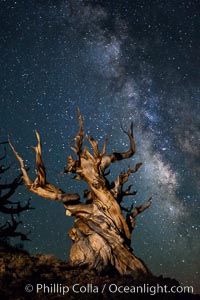
Stars and the Milky Way rise above ancient bristlecone pine trees, in the White Mountains at an elevation of 10,000' above sea level. These are some of the oldest trees in the world, reaching 4000 years in age.
Species: Bristlecone pine, Pinus longaeva
Location: Ancient Bristlecone Pine Forest, White Mountains, Inyo National Forest, California
Image ID: 27785
Species: Bristlecone pine, Pinus longaeva
Location: Ancient Bristlecone Pine Forest, White Mountains, Inyo National Forest, California
Image ID: 27785

The Milky Way Galaxy shines in the night sky with a Joshua Tree silhouetted in the foreground.
Location: Joshua Tree National Park, California
Image ID: 27806
Location: Joshua Tree National Park, California
Image ID: 27806

Milky Way at Night over Arch Rock, Joshua Tree National Park.
Location: Joshua Tree National Park, California
Image ID: 29197
Panorama dimensions: 7596 x 12603
Location: Joshua Tree National Park, California
Image ID: 29197
Panorama dimensions: 7596 x 12603
